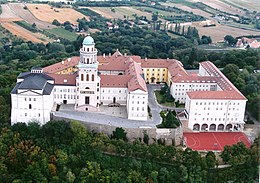| UNESCO World Heritage Site | |
|---|---|
 Pannonhalma Archabbey | |
| Location | Pannonhalma, Győr-Moson-Sopron County, Western Transdanubia, Transdanubia, Hungary |
| Criteria | Cultural: (iv), (vi) |
| Reference | 758 |
| Inscription | 1996 (20th Session) |
| Area | 47.4 ha (117 acres) |
| Buffer zone | 758 ha (1,870 acres) |
| Website | https://bences.hu/lang/en/ |
| Coordinates | 47°33′10″N 17°45′40″E / 47.55278°N 17.76111°E |
The Benedictine Pannonhalma Archabbey or Territorial Abbey of Saint Martin on Mount Pannonhalma (lat. Archiabbatia or Abbatia Territorialis Sancti Martini in Monte Pannoniae) is a medieval building in Pannonhalma and is one of the oldest historical monuments in Hungary. Founded in 996, it is located near the town, on top of a hill (282 m). Saint Martin of Tours is believed to have been born at the foot of this hill, hence its former name, Mount of Saint Martin (Hungarian: Márton-hegy), from which the monastery occasionally took the alternative name of Márton-hegyi Apátság. This is the second largest territorial abbey in the world, after the one in Monte Cassino.
Its sights include the Basilica with the Crypt (built in the 13th century), the Cloisters, the monumental Library with 360,000 volumes, the Baroque Refectory (with several examples of trompe-l'œil) and the Archabbey Collection (the second biggest in the country). Because of the exceptional architectural evolution of the abbey over its 1000-year history and its historical importance as an international cultural and religious center, the abbey and its surroundings were inscribed on the UNESCO World Heritage List in 1996.[1]
Today there are about 50 monks living in the monastery. The abbey is supplemented by the Benedictine High School, a boys' boarding school.
- ^ "Millenary Benedictine Abbey of Pannonhalma and its Natural Environment". UNESCO World Heritage Convention. United Nations Educational Scientific and Cultural Organization. Retrieved 29 April 2023.
